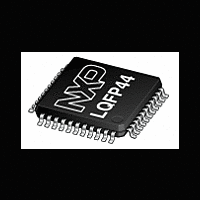XA-C3 NXP Semiconductors, XA-C3 Datasheet - Page 8

XA-C3
Manufacturer Part Number
XA-C3
Description
The XA-C3 is a member of the Philips XA (eXtended Architecture) family of high-performance 16-bit single-chip microcontrollers
Manufacturer
NXP Semiconductors
Datasheet
1.XA-C3.pdf
(68 pages)
GENERAL DESCRIPTION
The XA–C3 is a member of the Philips XA (eXtended Architecture)
family of high–performance 16–bit single–chip microcontrollers. The
XA–C3 combines an array of standard peripherals together with a
PeliCAN CAN 2.0B engine and unique ”Message Management”
hardware to provide integrated support for most CAN Transport
Layer (CTL) protocols such as DeviceNet, CANopen and OSEK. For
additional details, refer to the XA-C3 Overview on page 35.
The XA architecture supports:
FEATURES IN COMMON WITH XA-G3
XA-C3 SPECIFIC FEATURES
Philips Semiconductors
2000 Jan 25
Easy 16-bit migration from the 80C51 architecture.
16–bit fully static CPU with 24–bit addressed PROGRAM and
DATA spaces.
Twenty–one 16–bit CPU core registers capable of all arithmetic
and logic operations while serving as memory pointers.
An enhanced orthogonal instruction set tailored for high–level
support of the C language.
Multi–tasking and direct real–time executive support.
Low–power operation intrinsic to the XA architecture includes
Power–Down and Idle modes.
Pin–compatibility (CAN RxD and CAN TxD use the XA-G3 NC
pins).
32K bytes of on–chip EPROM PROGRAM memory (see Table 1).
44–pin PLCC (Figure 1 and Table 2) and 44–pin LQFP (Figure 2
and Table 3) packages.
Commercial (0 to 70 o C) and Industrial (–40 to 85 o C) ranges.
Supports off–chip addressing of PROGRAM and DATA memory
up to 1 megabyte each (20 address lines).
Three standard counter/timers (T0, T1, and T2) with
enhancements such as Auto Reload for PWM outputs.
UART–0 with enhancements such as separate Rx and Tx
interrupts, Break Detection, and Automatic Address Recognition.
Watchdog with a secure WFEED1 / WFEED2 sequence.
Four 8–bit I/O ports with 4 programmable output configurations
per pin.
32 MHz operating frequency at 4.5 to 5.5V operation.
One Serial Port Interface (SPI)
1024 bytes of on–chip DATA RAM.
XA 16-bit microcontroller family
32K/1024 OTP CAN transport layer controller
1 UART, 1 SPI Port, CAN 2.0B, 32 CAN ID filters, transport layer co-processor
1
XA-C3 CAN AND CTL FEATURES
LOGIC SYMBOL AND BLOCK DIAGRAM
Refer to Figure 3 for the logic symbol for the XA-C3 and to Figure 4
for a simplified block diagram representation.
UPGRADING XA-G3 DESIGNS TO CAN
42 vectored interrupts. These include 13 maskable Events, 7
Software interrupts, 6 Exceptions, 16 software Traps, segmented
DATA memory, multiple User stacks, and banked registers to
support rapid context switching.
External interfacing via a 16–bit DATA bus width.
A PeliCAN CAN 2.0B engine from the SJA1000 Stand–alone CAN
controller which supports 11– and 29–bit IDentifiers and the
maximum CAN data rate (1 Mbps) and CAN Diagnostics.
Hardware “Message Management” support for all major CTL
protocols: DeviceNet, CANopen, OSEK.
Automatic (hardware) assembly of Fragmented Messages via a
Transport Layer Co-Processor. Concurrent assembly of up to 32
separate interleaved Fragmented Messages
32 CAN Transport Layer (CTL) Message Objects are modelled as
a FullCAN Object Superset.
32 separate filters/screeners (one per Message Object), each
allowing a 30–bit ID Match and full 29–bit Mask (i.e., each
filter/screener represents a unique Group address).
Each Message Object can be configured as Receive or Transmit.
A separate message buffer is associated with each CTL Message
Object. 32 message buffers are located in XRAM and managed
by 32 DMA channels. Message buffer size for each Message
Object is independently configurable in length (from 2 to 256
bytes).
For single–chip systems there is a 512–byte (on–chip) XRAM
message buffer, independent of the 1K on–chip DATA RAM, which
is extendable (off–chip) to 8K bytes (i.e., 32 Message Objects that
can be up to 256 bytes each).
XA-G3 NC pins are XA-C3 CAN RxD and CAN TxD pins.
XA-G3 UART–1 is replaced by a Serial Port Interface (SPI)
XA-C3 software must never write to the BCR register
XA-C3 software must initialize BTRH and BTRL with 00h
Preliminary specification
XA-C3















